
How rare is it for chefs to walk away from a restaurant that has just been awarded a Michelin Star? Yet this is what happened in January 2010 when head chef Ryan Simpson and sous chef Liam Trotman made national headlines by parting company with the owner of The Goose at Britwell Salome. It says much for their culinary integrity that they rejected the owner’s plans for the address and decided instead to pursue a path that had brought them success, star or no star: A path that married the concept of ‘fine-dining’ with the modern day desire for ‘accessibility’, in other words a welcoming gastronomic restaurant with ‘relaxed formality.’ The formula is clearly a success as after five years since the opening of Orwells, they continue to thrive, with 60% of diners at any one time being regulars. Recognised in major Guides, Orwells has achieved three AA rosettes, 6/10 in the Good Food Guide – a notoriously hard marker – and inclusion in its top 100 restaurants. In 2012, the same guide awarded it Readers’ Restaurant of the Year.
The traditional whitewashed walls of the original pub belie the smart contemporary interior. The long room, with space for a maximum of 45-50 covers has a low oak beamed ceiling and wooden floor. It offers two dining areas, one brightly lit by the bar, the other at the far end being more cosy and subdued. Wall lighting, well-spaced tables dressed in fine napery and upholstered dining chairs make for refined and leisurely dining experience.
Front of House is led the engaging Kurt, Liam’s brother, who oversees service in a cheerful, welcoming and relaxed style. The young assistants are particularly well briefed on the components and preparation of each dish. The sommelier offers knowledgeable advice as well as thinking, like the two chefs, outside the box for a more adventurous approach.
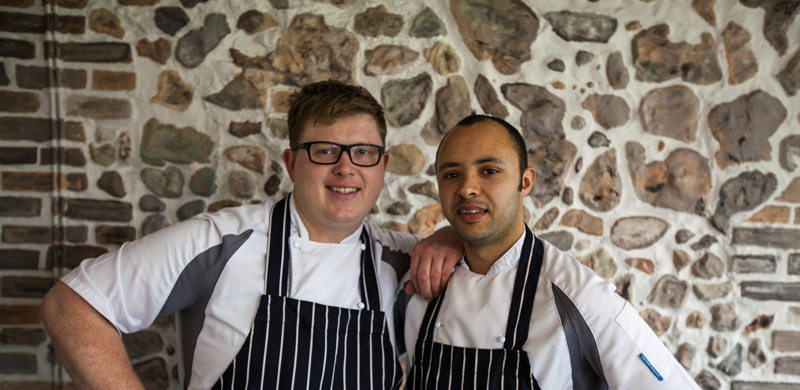
Ryan and Liam, with a team of four, have achieved a balanced division of labour, with Liam overseeing desserts whilst Ryan concentrates more on the savoury courses. Liam, a Liverpudlian by birth, started his career at the city’s famous 60 Hope Street restaurant before stints at Bovey Castle and Wintringham Fields, then finally joining Ryan at The Goose. At Orwells he also focuses on baking bread, (in which he offers popular classes in the restaurant’s kitchen), and growing vegetables in their smallholding in Lower Shiplake. Ryan served his culinary apprenticeship in France, overseen by such legends as the Troisgros family, Guy Savoy and Pierre Gagnaire. In England, he sharpened his skills in the kitchens of Restaurant Gordon Ramsay, Sketch, the Langham Hotel, Wintringham Fields and The Elephant in Torquay, before his appointment as head chef at The Goose, achieving a Michelin star after 18 months.
“Rural cooking with a modern approach” is how Ryan and Liam describe their food. “Rural” certainly reflects the restaurant’s location, surrounded by farmland at Shiplake Row, Binfield Heath in the south Oxfordshire countryside near Henley on Thames. More importantly, it captures the essence of their gastronomy, as seen in the essential rusticity of their dishes, a cuisine de terroir, embracing a real concern for sustainability and using the best local and seasonal produce. With 75% of vegetables home grown, the production of their own honey, the baking of their own bread, and the future rearing of their own pigs, Ryan and Liam remain true to this philosophy. Pork is currently sourced from the Windsor estate and Tamworth, venison from the Chilterns and duck from Crediton in Devon.
Not that “rural” cooking means simple cooking. The understated dishes give little idea of the successive stages of preparation and execution in marrying flavours successfully. Scrambled egg in an amuse bouche is cooked in a water bath before being siphoned into an egg shell. The dashi for a halibut dish is made from the fish bones, kombu, shitake, scented with lemon grass then slightly reduced. True understanding of flavour is shown in the same dish where the umami taste is heightened with a garnish of crispy Hen of the Woods mushrooms and white truffle, both being rich in amino acids. There is also a dalliance with the ‘Heston-like’ concept of revisiting childhood in a top end dining setting, this best exemplified by Brown sauce ice cream, a partner for pig’s cheek, which was created by Ryan to remind him of the emulsified butter and brown sauce taste in a bacon sandwich.
Whilst due regard is paid to classical skills, a “modern approach” is clearly evident. Contemporary techniques are used for instance in the sous vide preparation of meat and fish and the aeration of chocolate. Unusual but compatible combinations include lobster with capers and radish and scallops with chicken and leek. Stylish presentation, enhancing the finished product, is visible in the clean lines of uncrowded plates.
The sparsely worded menus at Orwells are ingredient led with no indication of cooking method or cut of meat, giving an element of surprise at the table. The carte offers a choice of six dishes in each course with a well-judged price point. Mains, apart from Highland Wagyu beef at £34) average £25 , starters £11 and desserts £9. A six course tasting menu at £69 with an optional £40 wine flight is the best way to sample the delights on offer. A set dinner with a choice of three dishes is a remarkable £24.95 for three courses, £19.95 for two. An impressive all British cheese menu comprises well known favourites including Stinking Bishop and Mrs Kirkham’s Lancashire along with more obscure varieties such as Tornegus.
Fine Dining Guide visited Orwells on a week day evening in early December, finding much to admire in the food and service.
Warm breads rolls, with their crisp crusts and soft crumb were impressive. In particular the Wessex Cobber was rich and malty and the Red Leicester so buttery it could easily have passed for a brioche
A playful amuse bouche, English Breakfast, presented in a egg shell resting on hay, featured creamy aerated scrambled egg and tiny cubes of black pudding and bacon. A hint of white truffle lifted this simple yet memorable opener.
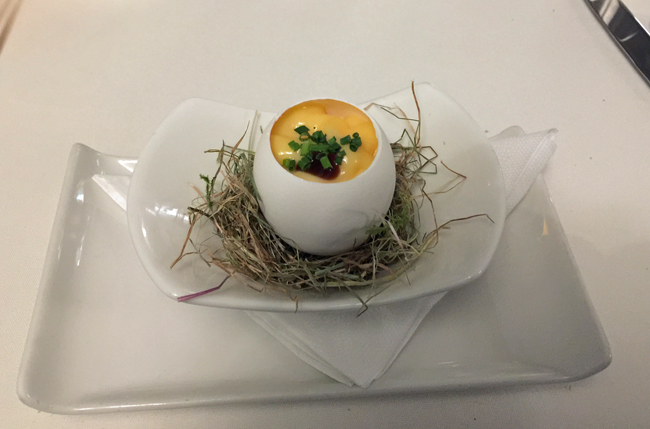
An element of theatre was provided by a signature starter of Smoked Pork. Served in a bell jar infused with a gentle smoke, the lifted dome released an ashen cloud masking a caramelised pig’s cheek of burnished mahogany. This delectable porcine morsel was succulent and meltingly delicious. Brown sauce ice cream added a luscious piquancy which cut the richness of the meat, whilst celeriac and carrot ribbons gave an autumnal garnish of earthy crispness. Overall, this brilliantly conceived dish was a visual triumph of aroma, taste, texture and temperature.
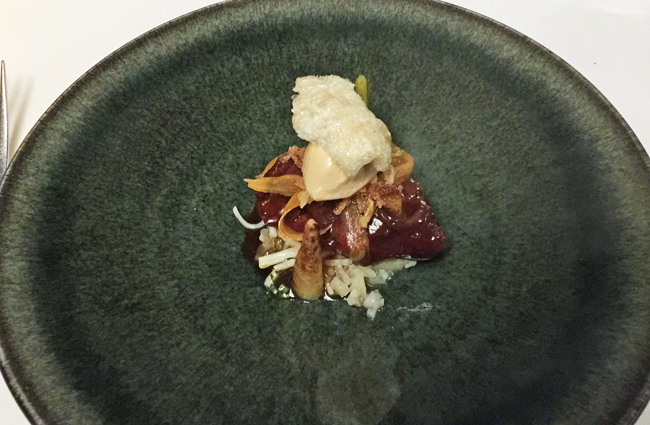
By contrast, a crab starter was delicate and light. The freshly prepared white meat, bound by a light herb mayonnaise, was dressed with paper thin tuiles of the brown meat and dried slices of cauliflower florets. A dressing of grapefruit provided the tart acidity which the dish needed.
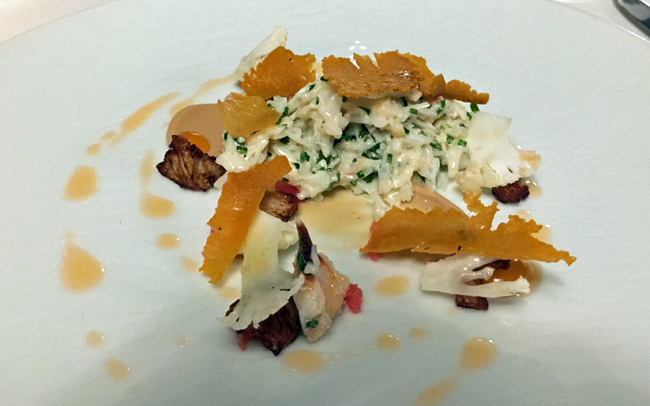
An intermediate course saw king scallops precisely seared to produce a caramelised crust and sweet, succulent flesh. Partnered with a rich and creamy risotto flavoured with white chocolate and white truffle, the balance of savoury and sweet flavours, with the heady, musty fragrance of the fungi, were well judged.
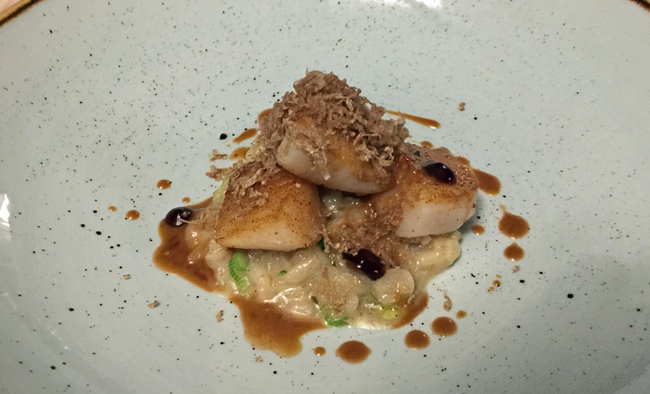
Breast of Creedy Carver duck for a main course was cooked sous vide to maximise its firm texture and rich, full flavour. Meltingly soft shredded confit leg meat provided a contrasting texture whilst the duck skin, served as crisp shards helped to offset the fattiness of the meat. Caramelised squash added an element of sweetness and salsify and pearl barley gave earthy flavour and contrasting texture. Finally, this composite plate was brought together by a light but intense duck jus.
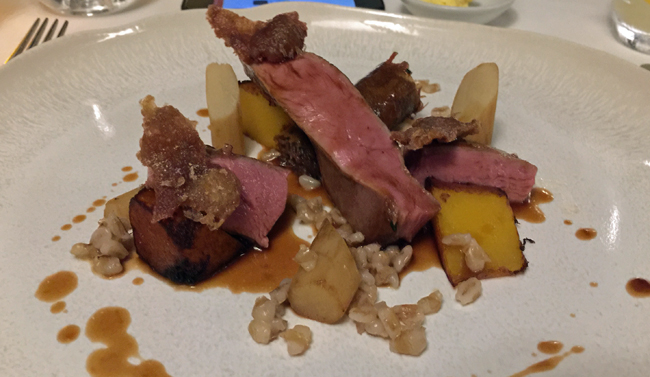
Precise timing did full justice to a generous fillet of halibut, the flavour of the meaty, translucent flesh being allowed to sing. Contrasting texture and umami flavour were provided by crisp Hen of the Woods mushroom, cabbage leaves and dashi. White truffle enhanced but did not overpower this impressive main course of four elements, which proved the principle that less can be more.
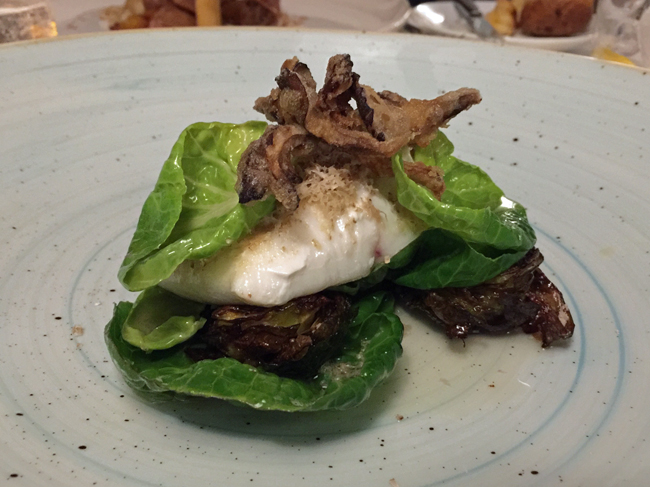
Desserts did not prove an anti-climax, as can so often be the case in high end restaurants.
A Trio of Chocolate showed technical skill and culinary invention. It featured white, dark and milk varieties layered in a rich but light mousse topped with a thin caramelised tuile and aerated milk chocolate. Peanut butter ice cream of velvety smoothness worked well with the other elements, with a scattering of toasted nuts gave a necessary crunch.
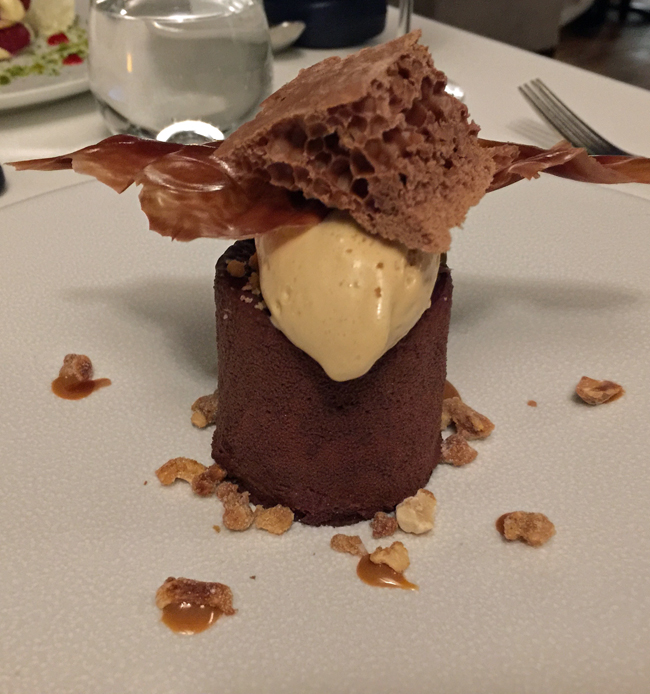
The recommended wine pairing of Frangelico hazelnut liqueur proved a perfect match for this decadent dessert.
Equally accomplished was the Raspberry mille feuille of thin, crisp Arlette pastry sandwiching well flavoured vanilla crème patissiere and fresh berries at room temperature. An intense pistachio ice cream and scattering of the chopped nuts gave contrasting colour, temperature and texture, whilst aerated white chocolate and raspberry coulis provided a final flourish.
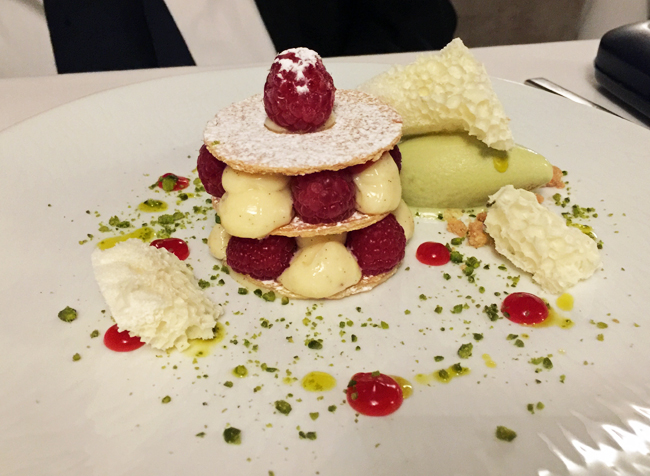
Good coffee with well-crafted passion fruit jellies, lemon meringue macaroons, chocolate truffles, peanuts and caramel completed a memorable meal.
Clearly, Ryan and Liam have an inexhaustible energy and creative drive that have bought them well deserved accolades for their inventive cuisine. Why they have not received a coveted star remains a mystery and is Michelin’s loss. Surely, it can only be a matter of time before they achieve this award. Fine Dining Guide thoroughly enjoyed its visit to Orwells, will definitely visit again, and will watch its progress with interest.



